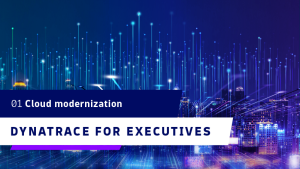Successful cloud modernization has a few key elements, such as partners that can help shepherd organizations through this journey.
As the process of cloud modernization becomes ever more complex, there is an even greater need to embrace the emerging role of cloud architect to accelerate transformation. One thing that’s imperative is modernization and digitization cannot be achieved alone. Partners are integral to the process and a necessity if organizations want to achieve faster, greater, and more scalable modernization.
Dynatrace recently hosted a webinar featuring Forrester Principal Analyst Lee Sustar on the current state of cloud modernization, the need to undergo this change, and how and why partners are a necessity rather than a nice-to-have in the cloud modernization process. Here are a few key takeaways from the discussion.
What is cloud modernization?
Modernization and transformation are happening all around us, but it’s how organizations approach those journeys that’ll set them apart from the “norm” and position them as leaders. But what is cloud modernization?
Cloud modernization is the ongoing process of taking legacy applications and updating their features, architecture, or infrastructure to ensure they’re optimized for operating in cloud environments.
The challenge organizations face is to do this quickly, securely, and reliably.
As a result, the role of the modernization champion has emerged to overcome those challenges.
What is a modernization champion, and what does this role do?
There are three personas that a modernization champion encompasses. These include developers, site reliability engineers (SREs), and cloud architects.
Each persona holds respective qualities for cloud modernization. But at a higher level, these champions ideate the future state of architectures, optimize and automate operations, and construct application delivery pipelines that bring the vision and benefits of cloud into reality and to life. Looking at the three roles specifically:
- Developers. They run what they build and enable shorter development cycles. By making development processes more efficient, developers boost software quality, help other IT teams adopt new architectures, and take responsibility for application security through shift-left and shift-right practices.
- SREs. They enable organizations to get into a position or release new features continuously at a large scale, while maintaining high-quality end-user experiences. By reducing toil, simplifying infrastructure provisioning, and managing outcomes to accelerate new feature rollouts, SREs make reliability measurable, scalable, and repeatable.
- Cloud architects. These individuals design and architect the next generation of cloud strategies. They also evaluate new technology, new services, and possible tooling, and they determine whether to migrate, modernize, or rebuild legacy applications.
These three personas form the foundation of a successful cloud modernization strategy. Cloud architects are at the core of modernization initiatives, while SRE and DevOps teams leverage the platforms and architecture and bring that modernization to fruition.
Considerations for a successful cloud modernization journey
The webinar concluded with questions from our attendees on the cloud modernization journey.
Q: For a company beginning its cloud modernization journey, what is the first step?
A: Targeting the low-hanging fruit at an organization is the best way to get started.
“I tell organizations, always try to figure out where are you going to have the biggest impact first. Now, that might not be your most critical application. It may be the second most important app, but it’s the one that’s most easily adapted to modernization — for example, if it’s aging out or needs a refresh. Then, that process becomes the model to which you can build some confidence and real-world results,” Lee said. “You can build a model — often with a partner — and watch them execute it, then taking it on your own. But the key is to focus on where you can create a model of success that can build on the support and skills needed to scale.”
Q: How can Dynatrace help organizations without a cloud architect in their modernization journey?
A: The role is still emerging, and few organizations have an in-house cloud architect. Those who have a cloud architect — or a team of architects — are becoming highly skilled in comparison to competition. For those organizations that lack the needed cloud architect skills, Dynatrace can help by connecting the customers or prospects with partners.
Partners are such an integral part of the cloud modernization journey because, more often than not, they have executed these projects previously. They have been through the trenches of cloud modernization and have the war wounds on their sleeves and lessons learned to impart.
Speaking more broadly, Sustar gave his this thought on partners, as well as their experience with cloud providers, or hyperscalers.
“Cloud providers have a lot of material that allows for the creation of a cloud architect function to really engage in mature systems and service adoption with the cloud architect approach,” Sustar said. “Whether that’s through published patterns, of a general sort or industry-specific, these are useful starting points for organizations at the start of their journey to utilize before bringing in an architectural practice to develop those capabilities over time rather than from scratch.”
Beyond cloud modernization
It’s no secret that organizations have ramped up cloud modernization at an unprecedented rate. As organizations look to the future, they should worry less about perfection and more about agility and resilience. Organizations should fail fast, fail often, and learn what works for them and their customers alike. Invest in the skills needed to continually modernize with those modernization champions and learn from others who have been there and done that so you can catapult into an extraordinary future.
To hear more of the conversation on cloud modernization with Lee Sustar, check out the on-demand webinar now.





Looking for answers?
Start a new discussion or ask for help in our Q&A forum.
Go to forum